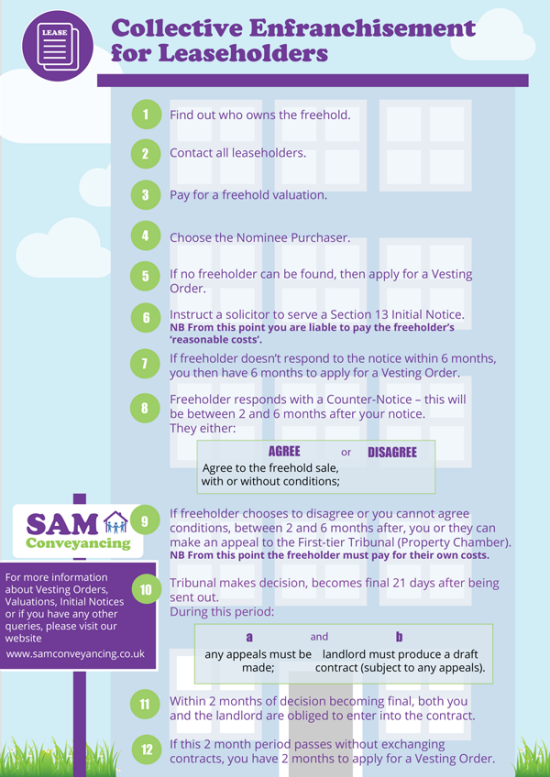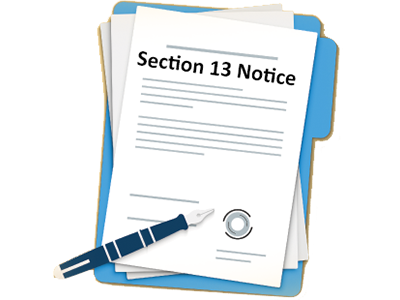Section 13 Notice When Buying Your Freehold
- The Section 13 Notice under the Leasehold Reform, Housing and Urban Development Act 1993, also known as an Initial Notice, is served by the leaseholders on the freeholder to exercise their rights to collective enfranchisement (buying your freehold).
- This is different to the Section 13 notice that a landlord serves on the tenant to increase rent.
- The freeholder is required to reply with a Section 21 Counter-Notice.
The Leasehold and Freehold Reform Act 2024 was passed on the 24th May 2024, but is not yet in effect and the date for this is not yet clear. We will update our content as and when the finalised legislation is published. Read more - Expected changes
What's in a Section 13 Initial Notice?
The content contained within the S13 notice is set out within the Leasehold Reform Housing and Urban Development Act 1993 Part I The Initial Notice Section 13 - Notice by qualifying tenants of claim to exercise right and the notice includes:
- 1
- the qualifying tenants giving the Section 13 Initial Notice;
- ALL the qualifying tenants;
- the landlord/freeholder and any intermediary landlords;
- the Nominee Purchaser/s;
- 2
- 3
- 4
- 5
- 6
- 7
- 8
- 9
- 10
Leasehold and Freehold Reform Act 2024
- House leaseholders will be able to buy the freehold of the house immediately on the purchase of the leasehold, eliminating the two-year period set out in the Leasehold Reform Act 1967.
- The evaluation method will be updated to eliminate the marriage value from the premium, and drop all future ground rent to 0.1% of the freehold value.
- Up to 50% of a qualifying building may be non-residential, whereas currently, the limit is 25%.
- The bill contains further clauses that were added at the report stage in February at the House of Commons, and amendments were put forward at the committee stage in April at the House of Lords.
Who is eligible to buy the freehold of a leasehold block of flats?
Under Section 13 - Notice by qualifying tenants of claim to exercise right, it states that a Notice 13:
"must be given by a number of qualifying tenants of flats contained in the premises as at the relevant date which is not less than one-half of the total number of flats so contained"
At least two flats must be involved; if there are only two leaseholders, then both must agree to buy the freehold.
What should you do before you serve the section 13 Notice?
- Check your eligibility
- Get a RICS Freehold valuation - you need to value the freehold to:
- know the participating leaseholders can jointly afford to buy the freehold;
- reduce the risk of serving an incorrect premium in the initial notice, which, when disputed by the landlord, can delay the process and cause additional negotiating costs with the freeholder.
- Choose your nominee purchaser/s
- Make contact with your freeholder or (if applicable) your intermediary landlord to inform them of your intention and to confirm they aren't absent. NB This also helps you ensure you serve notice on the right person/entity. If you don't, you risk invalidating your notice.
Freehold Valuation Cost
Your freehold valuation will depend on the number of leaseholds within the freehold. A small freehold of only two flats will cost hundreds of pounds, whereas a large apartment block will cost thousands; however, this cost will be split amongst the participating leaseholders. Get in touch for a bespoke quote today, with no obligation to proceed with us.
Choosing the Nominee Purchaser
The Nominee Purchaser, named in the Initial Notice, acquires the freehold and becomes the new freeholder if the process is completed.
You should decide who this is at an early stage because they will become the manager of the building. If you choose to set up a company, it needs to be set up and incorporated prior to serving your section 13 notice.
Along with other participating tenants, you are free to decide who the Nominee Purchaser is. They can be, for example:
- a person;
- one of the tenants;
- a corporate person/external company;
- a trust; or
- a company you form with the tenants for this purpose. This is the most common option as it allows you all to manage the company and share the responsibility of maintaining and adhering to the freeholder's obligations with the other freeholders, who all have voting rights.
Check that all leaseholders are eligible to buy your freehold first
The collective enfranchisement process is complicated, and there are numerous conditions to fulfil before you can progress to serving a Section 13 Initial Notice under the Leasehold Reform Housing and Urban Development Act 1993.
For example, at least two-thirds of the flats in the building must be occupied by qualifying tenants, you must have long leases, and more than 50% of the qualifying tenants have to be willing to buy the freehold.
You should also note that you must decide on a Nominee Purchaser to represent the interests of all the participating qualifying freeholders, which is required for serving the Section 13 Notice.

Serving a Section 13 Notice correctly is critical!
A conveyancing solicitor experienced in freehold purchase by leaseholders is fully aware that a Section 13 Notice served on a landlord/freeholder must be complete and with no inaccuracies.
If your landlord/freeholder finds faults in the notice, they can apply to court to have it dismissed. This means that your application is stopped and that you cannot make another application for 12 months.
Are you ready to serve an S13 Initial Notice on your freeholder?
The formal process of purchasing the whole freehold through collective enfranchisement of the qualifying tenants is more complex than a standard purchase of a single flat or house.
Choose a specialist solicitor who is well experienced with the process to handle your conveyancing smoothly, ensure the notice is served accurately and will be unphased in the unfortunate event that you have to apply to the first tier property tribunal.
Contact us for a bespoke quote, or call 0333 344 3234
What happens next?
The landlord must serve their counter-notice by the specified date (the minimum notice period after the s13 Notice is served is two months). If the freeholder fails to respond, you can apply to the county court for a Vesting Order.
Assuming they do serve this notice, you can reasonably expect that if you've hired the right professionals, the counter-notice will normally agree to your claim and you can then look to pay the landlord's premium, their compensation and for the final conveyancing required for the process to complete.
- 1Once your solicitor has served the notice, you are liable to pay your landlord's 'reasonable costs', which normally include what they have to pay for their own freehold valuation and their legal representation.
- 2If your landlord does not agree with your claim, they must say why in their counter-notice and then, at least 2 months after but not exceeding 6 months, either you or they have the right to take the matter to the First-tier Tribunal (Property Chamber). You have to pay a small sum to access this court but from this point, your landlord must pay for their own costs entirely, which is often the reason they'll choose to settle without taking this option.
Andrew started his career in 2000 working within conveyancing solicitor firms and grew hands-on knowledge of a wide variety of conveyancing challenges and solutions. After helping in excess of 50,000 clients in his career, he uses all this experience within his article writing for SAM, mainstream media and his self published book How to Buy a House Without Killing Anyone.
Caragh is an excellent writer and copy editor of books, news articles and editorials. She has written extensively for SAM for a variety of conveyancing, survey, property law and mortgage-related articles.









